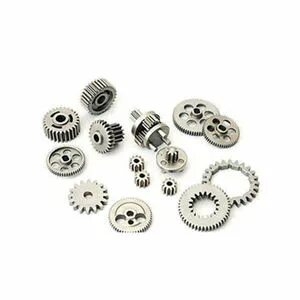Metal Injection Molding Powders Market Insights, Expand Huge Growth and Business Revenues & Forecast to 2030Posted by Pearl Smith on April 25th, 2023  Metal injection molding (MIM) powders are a type of metal powder that is used in the production of complex-shaped metal parts through the metal injection molding process. MIM is a manufacturing process that involves mixing fine metal powders with a binder material to form a feedstock, which is then molded into the desired shape. The molded part is then subjected to a debinding process to remove the binder, and then sintered to produce a final part with the desired mechanical properties. MIM powders are typically made from a range of metals and alloys, including stainless steel, titanium, tungsten, copper, and nickel. These powders are characterized by their fine particle size, high flowability, and consistent composition. MIM powders are typically produced using gas atomization, water atomization, or carbonyl processes, which produce spherical or near-spherical particles. The global metal injection molding powders market is driven by the growing demand for complex-shaped metal parts in a range of industries, including aerospace, medical, automotive, and electronics. The advantages of MIM powders over traditional manufacturing methods include the ability to produce parts with high precision and complex geometries, as well as the ability to produce parts in large quantities with minimal waste. Key players operating in the global metal injection molding powders market include Sandvik AB (Sweden), OptiMIM (U.S.), MIM International (India), CRS Holdings Inc. (U.S.), ARCMIM (U.S.), AmTech International (U.S.), Sintex a/s (Denmark), Sinotech (China), and Alpha Precision Group, LLC (U.S.) among others. One of the key drivers of this growth is the rising demand for miniaturization of products in industries such as electronics and medical devices. Metal injection molding powders enable the production of high-precision, small-sized parts with complex geometries, which is difficult to achieve through traditional manufacturing methods. Furthermore, the increasing demand for lightweight and durable components in the automotive and aerospace industries is also expected to boost the demand for metal injection molding powders. These industries require parts that are strong, lightweight, and can withstand high temperatures and pressures. In terms of materials, stainless steel is the most commonly used metal injection molding powder due to its excellent mechanical properties and corrosion resistance. However, there is a growing demand for titanium and other high-performance alloys, which offer superior strength and durability. Asia-Pacific is expected to dominate the metal injection molding powders market due to the presence of a large number of automotive, aerospace, and electronics industries in countries such as China, Japan, and South Korea. North America and Europe are also expected to contribute to the market growth, driven by the increasing demand for metal injection molding powders in the medical and dental industries. The demand for metal injection molding (MIM) powders is expected to grow in the coming years due to the increasing demand for complex-shaped metal parts in various industries. The key drivers of this demand include the need for miniaturization of products, the increasing demand for lightweight and durable components, and the growing demand for high-performance alloys. The electronics industry is a major consumer of MIM powders due to the increasing demand for miniaturized electronic devices. The medical industry is also a significant consumer of MIM powders, as the process enables the production of highly precise, small-sized components for medical devices. In the automotive and aerospace industries, MIM powders are used to produce lightweight and high-strength components such as engine parts, brake systems, and structural components. These industries require components that can withstand high temperatures and pressures, and MIM powders are capable of meeting these requirements. The demand for MIM powders is also driven by the increasing adoption of 3D printing technology in the manufacturing industry. 3D printing enables the production of highly complex parts with a high degree of precision, and MIM powders are an ideal material for 3D printing due to their fine particle size and consistent composition. The metal injection molding (MIM) powders market is expected to witness significant growth in the coming years, driven by several factors. One of the key drivers is the increasing demand for complex-shaped metal parts in various industries, including automotive, aerospace, medical, and electronics. MIM powders are capable of producing parts with high precision and complex geometries, making them ideal for these industries. The growing adoption of 3D printing technology is also expected to fuel the growth of the MIM powders market. MIM powders are an ideal material for 3D printing due to their fine particle size, consistent composition, and high flowability, which enables the production of complex parts with high precision. Furthermore, the increasing demand for lightweight and durable components is also driving the growth of the MIM powders market. MIM powders are capable of producing components that are strong, lightweight, and can withstand high temperatures and pressures, making them suitable for a range of applications. In terms of materials, the demand for titanium and other high-performance alloys is expected to grow in the coming years. These materials offer superior strength and durability, making them suitable for demanding applications in industries such as aerospace and medical. Metal injection molding (MIM) powders are used in a wide range of applications across various industries due to their ability to produce complex-shaped metal parts with high precision. Some of the major applications of MIM powders include: Automotive: MIM powders are used to produce various components such as engine parts, transmission components, brake systems, and structural components in the automotive industry. These components require high strength, durability, and dimensional accuracy, which MIM powders are capable of providing. Aerospace: MIM powders are used to produce parts for the aerospace industry, including engine components, turbine blades, and structural components. These components require high strength, corrosion resistance, and dimensional accuracy, which can be achieved through MIM powders. Medical: MIM powders are used to produce highly precise and small-sized components for medical devices such as dental implants, orthopedic implants, and surgical instruments. These components require a high degree of precision, biocompatibility, and corrosion resistance, which MIM powders are capable of providing. Electronics: MIM powders are used to produce miniaturized components for the electronics industry, including connectors, switches, and sensors. These components require a high degree of precision and dimensional accuracy, which MIM powders are capable of providing. Firearms: MIM powders are used to produce various firearm components such as trigger parts, hammers, and sears. These components require high strength and dimensional accuracy, which MIM powders are capable of providing. Like it? Share it!More by this author |


